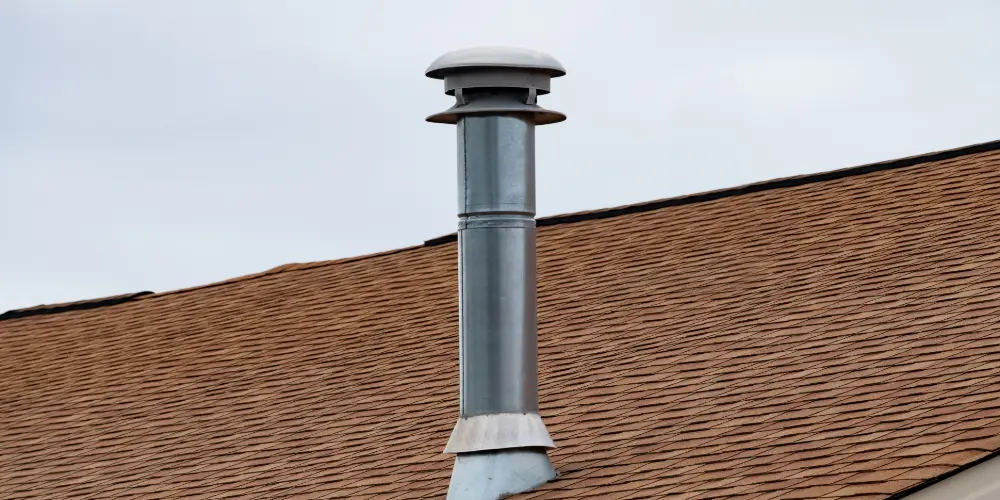Have you ever wondered about that mysterious pipe sticking out of your roof? The one that seems to do nothing?
It performs essential work, like the office oddball who quietly keeps things running while others get the glory.
We’re talking about your plumbing vent, an unassuming but indispensable part of your plumbing system.
In this article, we’ll dig into the wonderful world of drain vents to uncover their secrets and show a little love to your underappreciated sewer system.
What’s a Plumbing Vent?
A plumbing vent, or vent stack, ensures that water flows smoothly through your drain pipes, preventing foul odors or annoying gurgling sounds from backing up into your home.
This pipe extends through the roof, bringing fresh air into the plumbing system to maintain the correct atmospheric pressure in the drain pipes. With balanced pressure, wastewater can flow unimpeded to the sewer lines or septic system.
Ensuring Proper Drainage
Imagine you’re pouring water from a bottle, but it glugs and splutters. That’s what happens in your plumbing system without venting. Vents prevent airlock and allow water to drain freely.
No glugs and chugs, just free-flowing wastewater on its way to the treatment plant.
Preventing Sewer Gas Buildup
The vent’s opening to the atmosphere also allows sewer gas to escape. Minus this outlet, gas would build up in the system and eventually enter the home.
The plumbing vent equalizes air pressure within the traps — the curved pipes under fixtures — so that they form a water seal to keep gas out of living spaces.
That unassuming pipe poking out of your roof is critical for the smooth operation of your drainage system. It’s not just for show!
Components of a Plumbing Vent
The Vent Stack
The vent stack is the leading player in the venting system. It’s the vertical pipe protruding from the roof, channeling sewer gas upwards and out of the building.
It works with the drainpipes to keep the plumbing system pressure stable and prevent a vacuum that can disrupt trap performance and water flow. It serves as the ‘lungs’ for your plumbing system, providing airflow to keep things moving.
The Vent Cap
Think of the vent cap as the umbrella for your vent stack. It prevents debris, critters, and rain from entering the pipe. Despite this barrier, the vent cap still allows gas to escape freely.
Vent caps come in various materials and designs (for sewer style!), but all serve the same crucial function of protecting your plumbing vent system while allowing it to breathe.
The Vent Terminal
This is the topmost part of the vent stack visible on your roof. It provides an exit point for gas and ensures proper ventilation.
It must be high enough above the roof and other structural components to prevent the sewer gas from being drawn back into the building. Therefore, it’s subject to building codes dictating height and placement relative to windows, doors, and other openings.
Types of Plumbing Vents
The best venting system for a job depends on the home’s layout, local building codes, and the unique challenges presented by the plumbing system.
Common Vent Pipe
This is designed for back-to-back plumbing fixtures — like sinks in a shared wall between bathrooms. It connects both fixtures to a single vent stack, reducing the amount of piping needed within limited spaces.
Island Vent Pipe
An island vent pipe is the go-to solution for a sink or fixture that isn’t near a wall, such as a kitchen island. It employs a clever looping technique beneath the fixture to vent the drain, bypassing the need to tear into the floor or compromise structural integrity.
Air Admittance Valves (AAVs)
You’ll find air admittance valves in areas where conventional venting is difficult or intrusive. They allow air to enter the plumbing system when they detect negative pressure and prevent gas from seeping into the home. AAVs are an excellent option for retrofitting or adding to existing vent systems.
Loop Vents
Loop vents provide another good option for fixtures where conventional venting isn’t possible. They’re often used for fixtures on an island or peninsula layout, looping around to create a self-contained vent system.
Installing Plumbing Vents
- The vent stack should be as close as possible to the plumbing fixture it’s venting.
- Vent stacks must meet building codes and be at the correct height above the roofline.
- The vent’s diameter should be at least half that of the connected drain. Larger diameters can help with ventilation and reduce issues like glugging or gurgling noises.
- Drainage pipes must maintain a minimum slope of 1/4 inch per foot towards the main sewer line.
Other Considerations for Plumbing Vents
- Obstructions: Vent pipes should be unobstructed by trees, bird nests, or accumulated snow and ice.
- Local Climate: In areas with heavy snowfall or frigid temperatures, vent pipes should be insulated to prevent freezing, which can block the airflow and render the vent useless.
- Condensation: The difference in temperature between the inside and outside of a vent pipe may cause water to pool from condensation. Adequate insulation or an increased pipe diameter can mitigate this.
- Changes in Use Patterns: Changes to the plumbing system, like adding fixtures or increasing water usage, may require adjustments to the vent pipe system.
Maintaining Your Plumbing Vent
- Keep the vent cap clean and free of debris to prevent clogs.
- Regularly inspect for any damage or deterioration, especially after severe weather.
- If you suspect a blockage or issue with your plumbing vents, contact a professional plumber for an inspection and repairs.
Conclusion
And there you have it, folks! Plumbing vents may not be the stars of the show, but they’re essential cast members of your plumbing system, ensuring good drainage and keeping your home smelling fresh. So, next time you spot that pipe on your roof, give it a nod of appreciation!
FAQs about Plumbing Vents
Q: Do all plumbing fixtures need vents?
A: Every fixture that drains wastewater should have a corresponding vent to ensure proper drainage.
Q: Can I install vent pipes myself?
A: We recommend professional installation to ensure compliance with building codes.
Q: What should I do if I suspect a problem with my vent?
A: If you notice strange odors, slow drainage, or unusual noises in your plumbing system, call a plumber to inspect your vent and address any issues promptly.
Q: How often should my vents be inspected?
A: Include vent inspections as part of your regular plumbing maintenance routine, typically once a year or whenever you notice any signs of trouble.
Q: Are there any alternatives to traditional roof vents?
A: Air admittance valves (AAVs) allow air to enter the plumbing system without needing a traditional roof vent. They must be installed according to local codes.
Q: Can multiple plumbing fixtures share a single vent pipe?
A: Yes, multiple fixtures can share a single vent pipe as long as it’s appropriately sized to handle the combined demand and complies with local building codes.
Q: How can I tell if my vent is clogged?
A: Signs of a clogged vent include slow-draining sinks, gurgling toilets, or the smell of sewer gas within the home. If you experience any of these, it’s time to check for blockages or consult a professional plumber.
Q: Is there a height requirement for plumbing vent pipes above the roof?
A: A vent pipe must extend above the roof as local building codes dictate, typically at least 12 inches, to prevent clogs from debris.
Q: What materials are commonly used for plumbing vent pipes?
A: Plumbing vent pipes are commonly made from PVC (polyvinyl chloride), ABS (acrylonitrile butadiene styrene), copper, and cast iron. The choice of material often depends on the climate, local code requirements, and compatibility with the existing plumbing system.
Q: Do vent pipes require any special coatings or paints for protection?
A: Some vent pipes may benefit from special coatings or paints to protect against UV radiation, corrosion, and weathering, especially in harsh climates. Always use materials compatible with the vent pipe and adhere to local building codes.
Q: How does vent pipe diameter impact the plumbing system?
A: An undersized vent pipe can lead to poor venting and plumbing issues, while an oversized pipe unnecessarily increases costs and complexity.
Q: Can I cap my plumbing vents to keep out pests?
A: We don’t advise using anything that will disrupt airflow. However, you can install a purpose-built vent cap or screen.


